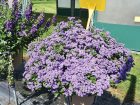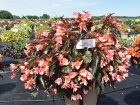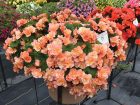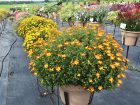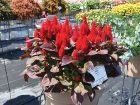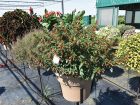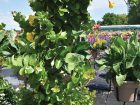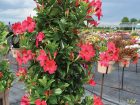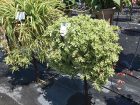
Features
New Varieties
Showstopping varieties on display
After years of trialling new and notable varieties, there are still lessons to be learned each and every time.
December 10, 2019 By Melhem Sawaya
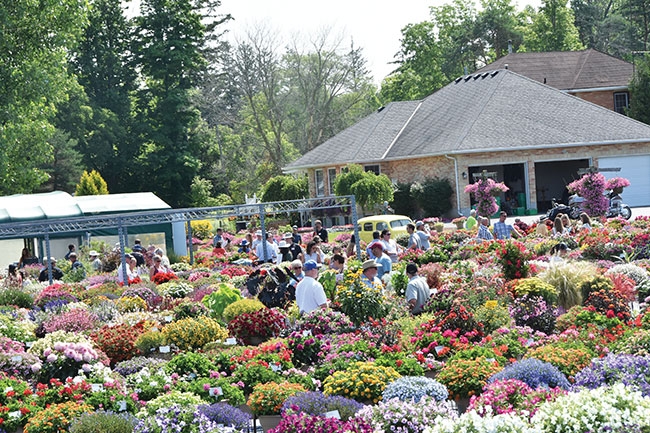 Over 300 people attended the Sawaya Garden Trials’ open house in Simcoe, Ont. this past July, with more visitors in the days that followed. All photos: M. Sawaya
Over 300 people attended the Sawaya Garden Trials’ open house in Simcoe, Ont. this past July, with more visitors in the days that followed. All photos: M. SawayaThis is the 19th year of the Sawaya Garden Trials, and every year I learn something new. Members of a series (families) can sometimes have the same performance but different colours. Other times, the families are only a collection of different colours of a genus under a certain commercial name, which is similar to a family of adopted kids. It is important to know if a genus is a true family or not for the following reasons:
- If you are growing a cultivar (colour) for the first time and you assume it has the same habit as the rest of the family, then you may be surprised by a totally different product that can sometimes end up being unsellable.
- When creating combinations of the same family (genera) and assuming they have the same response, you may be surprised with either different growth vigour and/or habits or different flowering times.
- In our trials, we usually have the old cultivars along with the new addition(s), so they can be compared to the older series in growth habit.
Lessons learned
There is important information that everyone can take away from the trials.
For how long in the season do the plants look good? Are they only good in June, or are they great the whole season? It’s important to learn about the flowering power and pattern of each cultivar – that is what I call flower stages.
How long do the flowers last and how fast do they regenerate? Hibiscus loses its flower in one or two days, but flower regeneration is almost instantaneous with multiple generations.
Some petunia varieties go to sleep after the rain and are full of botrytis right after, whereas other petunias are not affected by the rain and the plants keep on flowering in addition to being self-cleaning.
The geranium is one of the most important cultivars. It is great if grown in full sun without any rain on the flowers. If the flowers are not removed after the rain, they will be instantly full of botrytis and will spread to the rest of the plant. Double flower petunias fall into this group.
During the summer, I look for plants that are four- or five-flower generation plants. This means that even after the fifth set of flowers are established, the first set of flowers still looks good, which makes the plants look fresh and full of blooms without shedding of any old flowers or deadheading. An example of this is the gaura, some blue salvias, angelonia, and scaveola.
There is a lot of confusion around sun-loving and shade-loving plants. Almost 98 per cent of plants are more sun-loving rather than shade-loving. Some of the sun-loving plants are shade-forgiving, but will thrive in the sun. It is important to grow the plants right from the beginning in full sun if they are destined to finish in a sunny garden.
In a garden, starting with younger plants will improve their chance of surviving in less-than-optimal landscape conditions. This summer, we grew Non-Stop begonias in full sun and they performed very well. Many Boliviensis begonias were grown in full sun light, and the plants surprised many visitors with their outstanding performance. An example of that is the I’Conia Portofino adopted family, as we will see later in this article.
Over 250 combinations of different breeders were grown in the trials, and they ranged from many great ones to disastrous ones. In last month’s article, I shared details on how you can achieve profitable plant combinations. One of the aspects is to see the combinations in an unbiased trial where the true combinations are proven, and the bad ones are not hidden. So at least by not growing the failures, you will give your combinations a chance. We had a hanging basket contest, which were combinations created by different growers and will provide many new non-traditional ideas for you to explore.
Yes, these trials are in Ontario, Canada, but we grow plants for the outdoor summer months where temperatures are in the high twenties with high humidity, which allows us to grow tropical foliage plants with the possibility of taking these plants and enjoying them indoors at the end of the season. We will be expanding the selection of foliage tropical plants from different suppliers in the coming years. Know that new products are often times repackaged from older ones, like tropicals with flowering plants and combinations of succulents.
We used to think that some plants will not flower in our hot summers, but new breeding is helping these genera flourish with very surprising success. Access to tissue culture material is providing us with an excellent selection of plants that will perform successfully in our climate and improve the production of older ones. After all, almost all the vegetative stock starts with elite material from tissue culture. Every year, it is cleaned, reselected and built on as the elite stock. This is a big part of why we see better plant material from stock producers.
Every year there are new observations, new materials and new concepts that might keep us ahead of the curve. However, we can only find out if we take notice and try them. We can then either increase their production or drop them the year after, depending on production quality, consumer acceptance and profitability.
Over the last three to four years, over 150 acres shifted from flower production to cannabis production. It’s true that production area is tight now, but its impact is not much at all, which tells us that the flower industry is in a static mode and not growing even when residential building construction is at an all-time high.
That is why retailers, growers, brokers, and breeders share the responsibility in capturing consumer interest and promoting education as a top priority. Any person in this supply chain is part of the solution and if not, then they are part of the problem.
We have to keep learning and communicating with the consumer and the industry as a whole. If one operation fails, it is not an opportunity for other growers, but a loss for the industry.
I know of four operations that were once at the top of the greenhouse industry but have since disappeared or dropped to the bottom. The main reasons were their decisions to be closed in sharing their operational knowledge and their know-it-all attitude. I always give the example of how Mother Nature works in the Sea of Galilee, which takes water, gives water and thrives with living organisms. This is a sharp contrast to the Dead Sea, where it takes water but does not provide any. It is forecasted that the Dead Sea will be totally dead in a few years.
That is why these trials were started, why I started Grower Day in 1986, and why I practise every day as a way of life, not just a job.
This year’s showstoppers
This past year, we had close to 3000 cultivars. I am going to share examples of what we discussed, homing in on how they could be a benefit to your operation. The following varieties are listed alphabetically and not in any order of importance or popularity.
Agapanthus Bluety (1) Blue is a different bedding plant with blue flower clusters that last a long time. New ones sprout way before the older flowers are spent, ending up with over ten blooms. Agapanthus is excellent in large pots or as a central focus in the garden landscape.
Ageratum Artist Blue (2) is another outstanding blue flower on a well-branching plant with excellent botrytis resistance. That is great for monoculture patio pots or in combinations and as edging in large landscapes.
Alstroemeria Colorita Elaine Orange (3) is one colour of the Colorita compact series that does flower through the whole summer, putting on a great show. Colorita is excellent in large containers or landscape. No deadheading needed since the flowers last a very long time.
Angelonia Archangel Coral (4) is one colour of the vegetative Archangel Angelonia. Angelonia Serenita Rose (5) is one colour of the seed angelonia. Both series are heat-loving plants that will flower for the whole summer and will even get better as the weather warms. Six to seven generations of flowers, without any deadheading, will lead to large masses of flowers and put on an excellent show in containers or landscape. Angelonia should not be planted outdoors until the end of May in our area.
Bacopa MegaCopa Pink Improved (6) is one colour of the best bacopa series I have ever seen, simply because the flowers stand up to the heat better than any other series. In our trials this summer, all colours of the series flowered continuously until late fall.
Begonia I’Conia Upright Salmon (7) is a Boliviensis begonia. This variety from the I’Conia selection offered an excellent show in full sun and, along with the other I’Conia begonias, performed better than being grown in the shade. This summer, all of our trials were grown in full sun. Many that were supposed to be shade-loving proved to be shade-tolerant but thrived in the sun. My expectations were proven after all these years.
Begonia Whopper Rose Bronze Leaf (8) is the begonia king of the landscape. Whoppers are in between the Dragon Wing and Big begonias. Whopper flowers earlier than Dragon Wing, but not as early as Big. It does, however, branch better than Big. Whoppers are excellent all summer long, not water thirsty, and do not need deadheading. It shows well throughout the whole season.
Begonia Solenia Apricot (9) is one variety of the Solenia Rieger begonia family that excels when grown in full sun as well as tolerating the shade. I like the Solenias because they are versatile and more vigorous than the regular Rieger begonias, making them good candidates in mixed containers, large containers and landscape.
Begonia Waterfalls Encanto pink (10) is another Boliviensis begonia that is vigorous, with loads of flowers throughout the whole season. No deadheading required because it does that on its own. Excellent garden performer and gets better with heat and sun. Waterfalls begonia is great in large containers, especially large hanging baskets. This begonia needs continuous fertilizer when it is constantly watered or in rainy weather.
Bidens Popstar Red (11) is similar to the Yellow Popstar Compact, with long-lasting flowers and can withstand the summer heat better than other bidens. Popstar Red is great in combinations, especially ones that are not very vigorous.
Calibrachoas are the fastest growing genera in popularity among consumers, with their stunning colours, different flower patterns and flexibility in application.
Calibrachoa Chameleon Blueberry Scone (12) is proof of one variety that changes colour with age. This characteristic gives growers the flexibility to grow just one variety that will also supply them with a combination of different colours.
Calibrachoa Chameleon Double Pink Yellow in pictures #13 and #14 are of the same variety. The first one was taken in July and the second in August, showing you how durability and performance of this variety gets better with age. No deadheading or splitting. Chameleon is like any other calibrachoa – it needs continuous fertilizer. Chameleon is great in straight containers and combinations.
Calibrachoa Cabaret Red (15) is one colour in the most even series of calibrachoa I’ve seen. Cabaret is a medium-vigour series that can be grown in hanging baskets or 4” containers. It is also great in combinations.
Calibrachoa Superbells Unique Mango Punch (16) and Calibrachoa Superbells Unique Golden Yellow (17) are two colours that many growers are not very familiar with. Unique breeding shows off deep foliage colour and vibrant flower colours in a medium-vigour series that performed well in hanging baskets and combinations.
Calibrachoa Superbells Double Chiffon (18) is an excellent double calibrachoa colour-wise with a habit that looks great in large pots even when seen from afar. The Superbells Double Chiffon also makes any combination look richer.
Calibrachoa Kabloom Orange (19) and Calibrachoa Kabloom Cherry (20) are two seed variety calibrachoas that performed well in our trials. Calibrachoas from seed could be safer from viruses or other diseases, with minimal or no shipping problems. All we need from breeders is to give us seed that has a germination percentage.
Celosia Kelos Fire Pink (21) is a vegetative variety from the Kelos selection that is more suitable for outdoor than for indoor production. The plumes last a long time, so it is fairly maintenance-free. Kelos Fire’s pink plumes are like angelonia in the sense that the first plume and the next six to seven flushes of plumes look good. That is why the container looks as if it is exploding with colour.
Celosia Smart Look Red (22) is a seed variety; one of the Look celosia selection. It is one of my favourite celosia for its bright solid red plumes. Excellent for 4” pots or large pots when given enough production time.
Coleus Heartbreaker (23) is one of the many coleus varieties that stands out for its colourful leaves and growth habit. Heartbreaker is a vigorous grower but is solid and responds well to growth regulators with excellent garden performance.
Cuphea Vermillionaire (24) is a different cuphea that will take some dryness without totally collapsing like some other cupheas. If you’re looking for something different, birds love this excellent garden performer. It provides loads of little trumpets that hummingbirds love.
Diascia Towers of Power Apricot (25). Normally I do not like diascias because they do not take the heat well, but this variety never stopped flowering throughout the whole summer and had an excellent growth habit. It could be an excellent addition to any combination.
Dipladenia Opal Yellow (26) is not a good growing variety in the greenhouse due to the fact that it does not branch. However, when it is growing in the garden, it shines, branches and fills out with yellow flowers.
Dipladenia Bella Hot Pink (27) is one of the best dipladenias I have ever seen. Bella Hot Pink is a sturdy thick vine that is loaded with very long-lasting hot trumpets. Dipladenias are the highest class plant you could ever have in your garden. They are drought-tolerant, their blooms last a very long time, and they never stop flowering. The hotter and sunnier it is, the better the garden performance of dipladenia. Next year, we are going to have a significant number of different dipladenia varieties.
Dorotheanthus Variegated (28) is a waxy leaf trailing variety that enhances many combinations and in the summer, the little red flowers are a bonus. Needless to say, Dorotheanthus is very drought-tolerant and overwatering does not kill it. Try to plant the Dorotheanthus in the middle of your combination where only one cutting will branch, giving a nice contrast to any flowering variety you plant with.
Garden Party Diane (29) is one of the perennial party combinations that performed very well in our trials. Rooted liners were planted towards the end of May and they were ready mid-July. They stayed looking great the whole summer long, and then I planted them in my garden to enjoy for the next season.
Gaillardia Spintop Red Starburst (30) is a first-year, no-vernalisation variety that flowers all summer long. I would try to include Spintop and other first-year perennials in annual combinations.
Last bit of advice
Always try new varieties and if all works well, increase production the next season or drop it. It has been established that new varieties you have never grown before are the number one reason for shrinkage in production, but learning to grow the new varieties and including them in your program is a must.
Stay tuned. I will share the remainder of my selected varieties with you in my next article.
Melhem Sawaya of Focus Greenhouse Management is a consultant and research coordinator to the horticultural industry. Contact him at mel@focusgreenhousemanagement.com
Print this page

